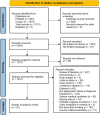Smoking in primary headaches - a systematic review and meta-analysis
- PMID: 40468190
- PMCID: PMC12139338
- DOI: 10.1186/s10194-025-02076-2
Smoking in primary headaches - a systematic review and meta-analysis
Abstract
Background: Primary headaches mainly consist of headaches such as migraine, tension-type headache (TTH), and cluster headache (CH). There is contradictory data concerning the association between smoking cigarettes and headaches. The objective of this study was to evaluate the prevalence of an association between smoking and primary headaches.
Methods: A systematic review was conducted using the Preferred Reporting Items for Systematic Reviews and Meta-Analyses (PRISMA) 2020 guidelines. PubMed and Scopus were screened up until February 2025. Next, those studies with eligible criteria related to this topic were included in a meta-analysis. To assess risk of bias, the Joanna Briggs Institute tool (JBI) was used. The random effects model was used to estimate odds ratios (OR) and smoking prevalence.
Results: There were 2,713 records out of which 37 studies were included in the meta-analysis. 22 out of the 37 included studies had a low risk of bias. The prevalence of smoking in migraine was 20% (95% CI: 16–24) and in migraine with aura (MwA) 27% (95% CI%: 17–27). For TTH, the prevalence was 19% (95% CI: 7–34) and in CH, it was 65% (95% CI: 55–76). The overall smoking prevalence in primary headaches was 32% (95% CI: 8–62). Current smoking was associated with an increased risk of migraine (OR = 1.29, 95% CI: 1.02–1.62, p = 0.034) compared to the group without any headache. Meta-regression revealed that neither age, sex, nor year of publication influenced this result. Current smoking was associated with a decreased risk of TTH (OR = 0.78, 95% CI: 0.68–0.89, p < 0.001). No association was observed between current smoking and CH and MwA; additionally, no association was found between former smoking and migraine. Meta-regression could not be conducted for TTH and CH.
Conclusions: Current smoking was associated with an increased risk of migraine and a decreased risk of TTH. There was no association between current smoking and CH despite the fact that over half of CH patients smoked. The influence of electronic cigarettes commonly used these days is not yet explored in primary headaches, despite the wide-spread use of such cigarettes among the young population who are vulnerable to primary headache onset.
Supplementary Information: The online version contains supplementary material available at 10.1186/s10194-025-02076-2.
Keywords: Cigarette; Exposure; Factor; Lifestyle; Nicotine; Tobacco; Trigger; Vaporize.
Conflict of interest statement
Declarations. Competing interests: The authors declare no competing interests.
Figures












References
-
- Steiner TJ, Stovner LJ (2023) Global epidemiology of migraine and its implications for public health and health policy. Nat Rev Neurol 19(2):109–117 - PubMed
Publication types
LinkOut - more resources
Full Text Sources
Miscellaneous

